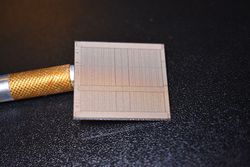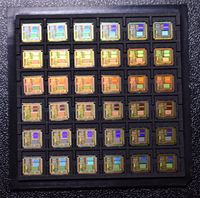| Line 1: | Line 1: | ||
{{title|Die}} | {{title|Die}} | ||
| − | [[File:ibm power9 die.jpg|right|thumb|IBM {{ibm|Power9|l=arch}} die.]] | + | [[File:ibm power9 die.jpg|right|250px|thumb|IBM {{ibm|Power9|l=arch}} die.]] |
| − | A '''die''' is the actual IC chip and is the final product of the [[fabrication process]]. It is the individual chip made following the [[singulation]] of a [[wafer]]. Dies typically undergo packaging before being sold to the customer as a final product. | + | [[File:6x6_waffle_pack.jpg|right|thumb|200px||A [[waffle pack]] with 36 dies.]] |
| + | A '''die''' is the actual bare IC chip and is the final product of the [[fabrication process]]. It is the individual chip made following the [[singulation]] of a [[wafer]]. Dies typically undergo packaging before being sold to the customer as a final product. | ||
== Overview == | == Overview == | ||
Revision as of 11:13, 11 May 2020


A die is the actual bare IC chip and is the final product of the fabrication process. It is the individual chip made following the singulation of a wafer. Dies typically undergo packaging before being sold to the customer as a final product.
Overview
The die is the final product of the fabrication process. A fully processed wafer will under singulation following probing. Depending on the application, the die may be shipped to an assembly/packaging plant where it will undergo encapsulation, producing the final chip that ships to customers.
Die size
Die size refers to the length and width of the die. Since the die size and shape determines the total number of dies that may be realized from a single wafer, the die size is a strong indicator of cost.
| Select Large Dies | |||
|---|---|---|---|
| GPU | Server | Desktop | Mobile |
|
|
| |
This list is incomplete; you can help by expanding it.